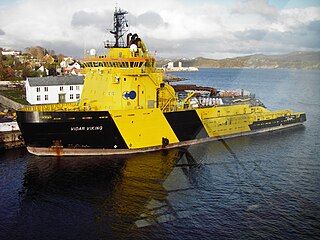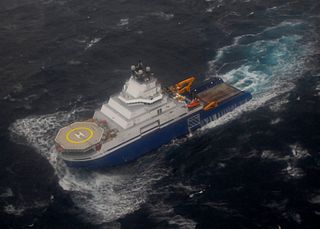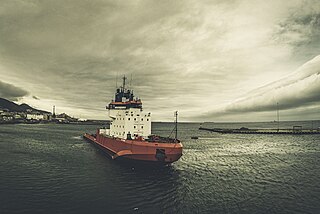
An icebreaker is a special-purpose ship or boat designed to move and navigate through ice-covered waters, and provide safe waterways for other boats and ships. Although the term usually refers to ice-breaking ships, it may also refer to smaller vessels, such as the icebreaking boats that were once used on the canals of the United Kingdom.

CCGS Terry Fox is a Canadian Coast Guard heavy icebreaker. She was originally built by Burrard-Yarrows Corporation in Canada in 1983 as part of an Arctic drilling system developed by BeauDril, the drilling subsidiary of Gulf Canada Resources. After the offshore oil exploration in the Beaufort Sea ended in the early 1990s, she was first leased and then sold to the Canadian Coast Guard.

MSV Fennica is a Finnish multipurpose icebreaker and offshore support vessel. Built in 1993 by Finnyards in Rauma, Finland and operated by Arctia Offshore, she was the first Finnish icebreaker designed to be used as an escort icebreaker in the Baltic Sea during the winter months and in offshore construction projects during the open water season. Fennica has an identical sister ship, Nordica, built in 1994.

Canada's early petroleum discoveries took place near population centres or along lines of penetration into the frontier.
SCF Sakhalin is a Russian icebreaking platform supply and standby vessel owned by SCF Sakhalin Vessels Limited, a subsidiary of Sovcomflot. The ship was built by Aker Finnyards Helsinki shipyard in Finland in 2005 as FESCO Sakhalin for Far East Shipping Company (FESCO), but was purchased by Sovcomflot and renamed in 2010. Since the beginning it has been in long-term charter for Exxon Neftegas Ltd. and used to supply oil platforms in the Sakhalin-I project.

CCGS Captain Molly Kool is a Canadian Coast Guard converted medium class icebreaker. She was originally built as an icebreaking anchor handling tug Vidar Viking for Trans Viking Icebreaking & Offshore in 2001. The vessel was acquired by the Canadian Coast Guard in August 2018 and was commissioned in May of the next year after refit.
A double acting ship is a type of icebreaking ship designed to travel forwards in open water and thin ice, but turn around and proceed astern (backwards) in heavy ice conditions. In this way, the ship can operate independently in severe ice conditions without icebreaker assistance but retain better open water performance than traditional icebreaking vessels.

CCGS Jean Goodwill is an icebreaking anchor handling tug supply vessel (AHTS) converted to a medium class icebreaker for the Canadian Coast Guard. She was originally built as Balder Viking for Trans Viking Icebreaking & Offshore AS in 2000. The vessel was sold to Canada in 2018 and was initially expected to enter service in late 2019 following a refit. However, due to delays the conversion of the vessel was not completed until November 2020.

Vladimir Ignatyuk is a Russian icebreaking anchor handling tug supply vessel. She was built by Burrard-Yarrows Corporation in Canada in 1983 as Kalvik as part of an Arctic drilling system developed by BeauDril, the drilling subsidiary of Gulf Canada Resources. After the offshore oil exploration in the Beaufort Sea ended in the early 1990s, she was sold to the Canadian shipping company Fednav in 1997 and renamed Arctic Kalvik. In 2003, she was purchased by Murmansk Shipping Company and transferred to Russia.

Aiviq is an American icebreaking anchor handling tug supply vessel (AHTS) owned by Edison Chouest Offshore (ECO). The $200 million vessel was built in 2012 by North American Shipbuilding in Larose, Louisiana and LaShip in Houma, Louisiana. She was initially chartered by Royal Dutch Shell to support oil exploration and drilling in the Chukchi Sea off Alaska where the primary task of the vessel was towing and laying anchors for drilling rigs, and oil spill response.

Vitus Bering is a Russian icebreaking platform supply and standby vessel owned by Sovcomflot. Built by Arctech Helsinki Shipyard in Helsinki, Finland, she and her sister ship, Aleksey Chirikov, were ordered on 16 December 2010, shortly after the joint venture agreement between STX Finland Cruise Oy and United Shipbuilding Corporation had been signed. Delivered to the owners on 21 December 2012, Vitus Bering is used in the Arkutun-Dagi offshore oil field in the Sea of Okhotsk.
Arcticaborg (Арктикаборг) is an icebreaking platform supply vessel. She was previously operated by Wagenborg Kazakhstan in the Caspian Sea but was transferred to Canada in 2017 and acquired by Fathom Offshore in 2018. In 2019, she was contract to Russia for two years.
Aleksey Chirikov is a Russian icebreaking platform supply and standby vessel owned by Sovcomflot. She and her sister ship, Vitus Bering, were ordered on 16 December 2010 from Arctech Helsinki Shipyard in Helsinki, Finland, shortly after the joint venture agreement between STX Finland Cruise Oy and United Shipbuilding Corporation had been signed. Aleksey Chirikov was delivered on 19 April 2013. She will be used in the Arkutun-Dagi offshore oil field in the Sea of Okhotsk.

Polaris is a Finnish icebreaker. Built in 2016 by Arctech Helsinki Shipyard, she is the most powerful icebreaker ever to fly the Finnish flag and the first icebreaker in the world to feature environmentally friendly dual-fuel engines capable of using both low-sulfur marine diesel oil (LSMDO) and liquefied natural gas (LNG). Polaris was initially ordered by the Finnish Transport Agency, but the ownership was transferred to the state-owned icebreaker operator Arctia after delivery.
Single steel drilling caisson is a drill barge that was built for year-round oil exploration in shallow ice-covered waters in the Beaufort Sea. The unit, initially named SSDC and later shortened to SDC, was converted from an old oil tanker in the early 1980s. It has been used to drill a total of eight oil wells on both Canadian and U.S. continental shelves, the most recent in 2006.

Novorossiysk is a Russian Project 21900M diesel-electric icebreaker. She was built by Vyborg Shipyard in Russia and delivered to Rosmorport in 2016.
Robert LeMeur was an icebreaking platform supply vessel used to support oil exploration in the Beaufort Sea. Built in 1982 by Burrard Yarrows Corporation in Vancouver, British Columbia, she was part of the fleet of Canadian icebreakers, drillships and support vessels operated by Canadian Marine Drilling (Canmar), the drilling subsidiary of Dome Petroleum and later Amoco Canada Petroleum Company.
Zhong Shan Da Xue Ji Di is a Chinese icebreaker owned by the Sun Yat-sen University. She was built in 1983 as an icebreaking anchor handling tug supply vessel (AHTS) Ikaluk for BeauDril, the drilling subsidiary of Gulf Canada Resources, to support offshore oil exploration in the Beaufort Sea. In the 1990s, the vessel was acquired by Canadian Marine Drilling (Canmar) and renamed Canmar Ikaluk. In 1998, she was purchased by Smit International and served in the Sakhalin oil fields as Smit Sibu. In 2009, she was acquired by FEMCO Management and in 2012 given back her original name. Ikaluk was sold to China in February 2018 and renamed Beijing Ocean Leader. In late 2021, the vessel was acquired by its current owner.

Kigoriak is a Russian icebreaking anchor handling tug supply vessel. Built by Saint John Shipbuilding & Dry Dock Company for Canadian Marine Drilling (Canmar) in 1979 as Canmar Kigoriak, she was the first commercial icebreaking vessel developed to support offshore oil exploration in the Beaufort Sea.
CCGS Judy LaMarsh is a Canadian Coast Guard light icebreaker. Built in 2010 as a shallow-draught icebreaking tug Mangystau-2 for the Caspian Sea oil fields, the vessel was acquired by Canada as an interim solution while the existing fleet undergoes service life extension and maintenance.










